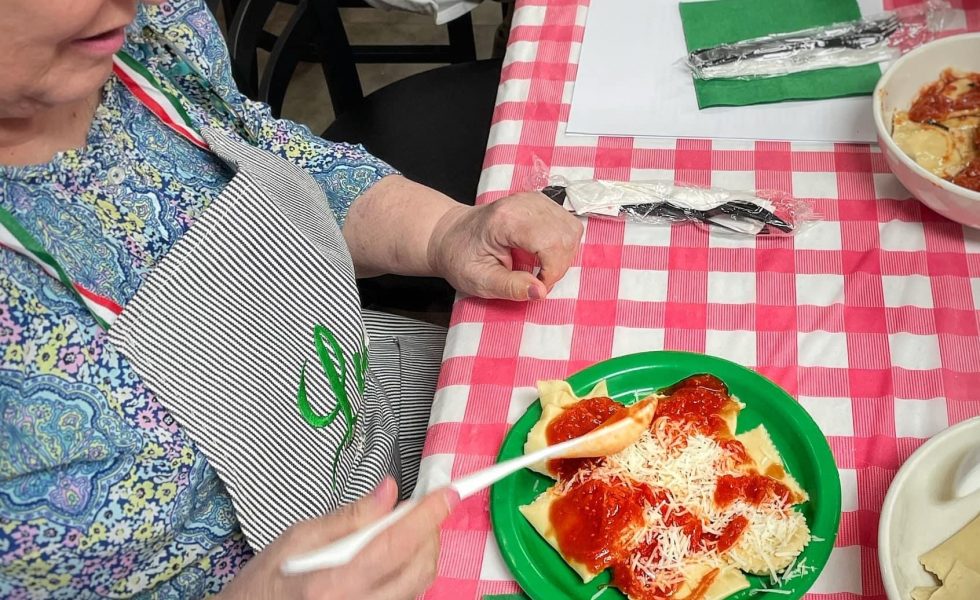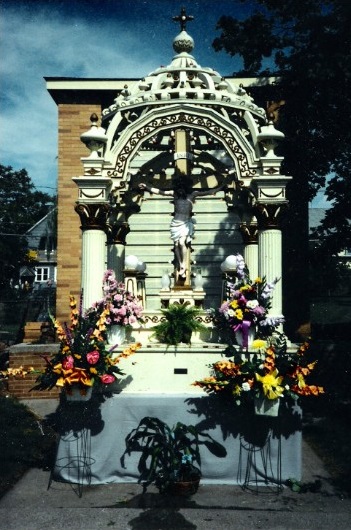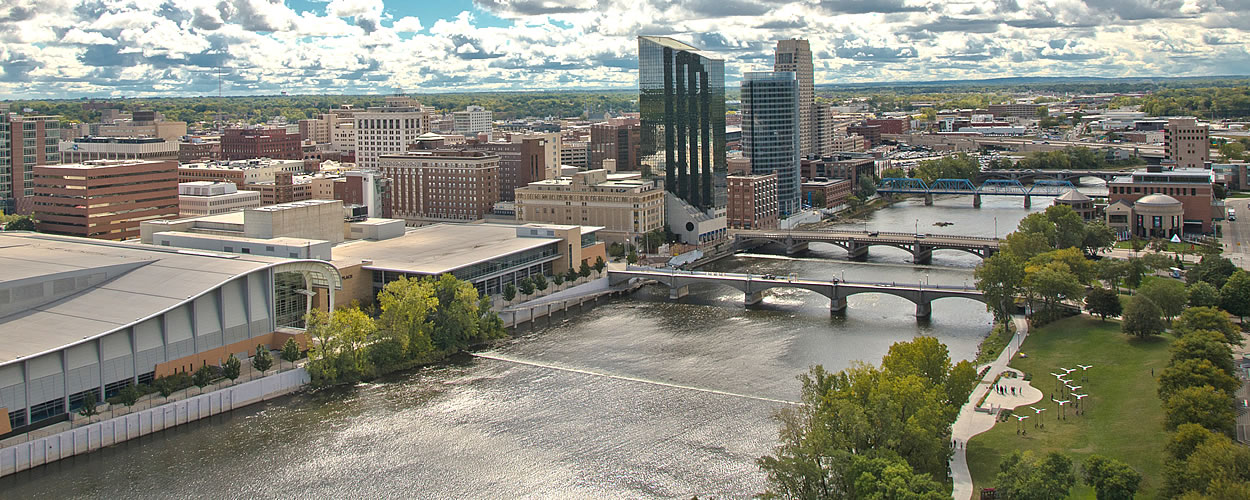
Local Italian Culture
The Origin
“Little Italy.” That phrase conjures up neighborhoods in New York, Chicago, Milwaukee, San Francisco and many other cities in the U.S. Grand Rapids also had its “Little Italy” and many of our members were a part of it. Lou Educato is one of them. Little Italy in Grand Rapids was bounded unofficially by Wealthy St. on the north, Madison Ave. on the east, Burton St. on the south, and the railroad tracks on the west. Within that area were the many Italian immigrants who arrived here in the late 1890’s and through the early part of the 20th century. Others scattered about the city, but the concentration was within those boundaries.

The vast majority of immigrants were uneducated, yet they were enterprising and willing to work. As Lou Educato tells us, “My mother finished the third grade and was then forced to quit to help at home to help care for five brothers and a sister… This was common for most families. The girls helped at home and the boys found a job to help with living expenses.” Some had their little corner grocery stores, like G. B. Russo & Sons, the Terranova, and Bulgarella families. The aroma of Italian cheeses, salami, oregano, basil and rosemary, as one entered those stores, was a little bit of heaven.
If you wanted certain services at your doorstep, that was also available. Milk and ricotta cheese was delivered from Palazzolo’s Dairy; numerous peddlers called out their wares and pushed their carts up and down the streets. They peddled everything from fresh fish, chickens, meats, clothing, bedding and everything in between. Many Italians also worked for the railroad and businesses in town. There were two pool halls, social clubs for young Italian men, on Division Ave. Gambling was illegal, but card games like scopa and briscola, played across the country, were regularly played for money and entertainment. The scores came in from all over the country by the old Western Union telegraph ticker tape machine and were then written on the blackboard in the hall. Most events happening in the Italian communities were put up on the board.
Community and Religion
On the corner of Sheldon and Hall St. was the Italian parish, Our Lady of Sorrows. It was the epicenter of the religious and social life of the Italian community here in Grand Rapids. Established by Padre Salvatore Cianci in 1908, it remained a vibrant Italian community well into the 1960’s. Various Italian communities, from Montelepre (Sicilia), Calabria, Roma (Lazio), celebrated throughout the year their distinctive feste and then, at a certain point in the summer, they would all come together for a weekend for La Festa Italiana. There were Italian booths from the various regions, and a band played through each of the evenings. The event would culminate after the last Mass on Sunday in the great procession with the band playing and marching behind the grand Baldacchino with the Crucifix. The Baldacchino was carried on the shoulders of forty men and the procession would proceed throughout the Italian community in the area. The Italian women would march with candles and most would march barefoot, praying and reciting the rosary.

The Baldacchino, a piece of Italian pious or folk art, designed and executed in 1922 by the Italian artist Giuseppe Di Leonardo, sadly deteriorated as it sat for years in a garage on the church property. Now restored beautifully, it is preserved in the Grand Rapids Museum and represents the Italian cultural heritage of Grand Rapids. Fr. Cianci, pastor of our Lady of Sorrows (1908-1955) was the anchor in the Italian community. He was confessor, confidant, translator, and advisor in business matters and defender in legal and civil matters. Many can still recall attending his Masses and hearing him deliver his fiery homilies. They were delivered first in English, then in Italian. Although the theme would be similar, the Italian version would often contain a heated scolding of his flock, encouraging them to reach their potential in education, employment, marriage, life, and spirituality. He often would include some familiar off-colored word to add emphasis to his spell binding oratory. He was a savior both spiritually and emotionally for his people. He truly was a shepherd who overlooked and cared for his flock. He smelled like his sheep.
Key Figures
Louis E. Maggini (1912-2005) became the first Italian-American lawyer who assisted and helped many an immigrant in Grand Rapids’ “Little Italy.” Whether it was legal advice or how to become an American citizen, he guided them through the processes. In 1961, a second lawyer from the Italian community came on the scene, Louis John Educato. He and Maggini became law partners for over twenty-five years. As the Italian community grew and prospered through hard work and persistence, many attained wealth and high standing in the greater Grand Rapids area. One of the highlights was when President George H. W. Bush appointed Peter Secchia, a third generation son of Italian immigrants, Ambassador to Italia, where he served from 1989-1993.
Peter was former chairman of the Michigan Republican Party. He came to Grand Rapids after graduating from Michigan State University, which he strongly supports, and worked his way up in the lumber business and eventually became the owner of the very successful Universal Forest Products. Whether it’s the Secchia Foundation (which serves many and goes unhailed), or the Secchia Institute for Culinary Education, or the Secchia College of Human Medicine (an MSU campus along I-196, part of the “Medical Mile”), or Secchia Apartments for Students just west of the S-curve, or even his and Joan’s CarePartners Program for Children at the Helen DeVos Children’s Hospital, we can see his generosity and his influence through his contributions to Grand Rapids and its landscape.
The Italian American Club
Peter became, in 1983, the first president of the Sons of Italy Club, at the urging of Fr. Julian Reginato. At the time, Fr. Julian was a Consolata Missionary priest who became pastor of Our Lady of Sorrows (1978-1985). In fact, when we had our own Festa Italiana downtown during the 1980’s and 1990’s, Fr. Julian would preside at liturgy on Sunday morning on the main stage for all of us in the Club before the booths opened at ten o’clock. However, we had to discontinue that beautiful practice because of matters of Church and State. Fr. Julian is now a retired priest from the Diocese of Grand Rapids. He called the first meeting of the local Italian community together on a hot September day in 1983, in a room above what was then Bono’s Ristorante on Plainfield in Creston Heights. Then shortly thereafter, Fr. Julian called the first actual meeting at Our Lady of Sorrows where he drafted Peter as the Club’s first President. We owe Fr. Julian a debt of gratitude whose idea it was to have such a club in West Michigan. The Sons of Italy has now become this Club, The Italian American Club of West Michigan. A list of the original charter members is now on a plaque in Pietro’s Italian Restaurant here in Grand Rapids. Lou Educato is among those listed.
Today
The face of “Little Italy” began to change with the return of the men and women after WW II, the Korean War, and the Vietnam War. They had seen different countries, cultures, and different ways of life. Many brought home non-Italian wives. Many married outside of their Catholic faith and drifted away from their roots. Slowly they left the area they called home for the suburbs. The area changed. The older generation had died off and urban renewal set in. Much of Little Italy slowly disappeared. Hundreds of the old homes were demolished. The entire railway tracks were removed. Even streets disappeared.

If you were to go there now, you would find a city market, many huge industrial buildings and warehouses, the disappearance of parks, and the erection of many government housing projects. A second government housing project on the corner of Ionia and Franklin is where Fr. Cianci’s park used to be. The Italian grocery stores have vanished, together with the street peddlers, the Italian dairy, the pool halls, and everything else that once comprised “Little Italy.” Our Lady of Sorrows church still remains. It’s the last remnant of the once vibrant Italian community. However, it’s scheduled to be closed when the present priest retires or dies.
Written by Gregory Carnevale, based on reflections provided by Lou Educato, a charter member of our Club, who recalled all of this so vividly, having been raised in those environs.
 Italian American Club of West Michigan
Italian American Club of West Michigan